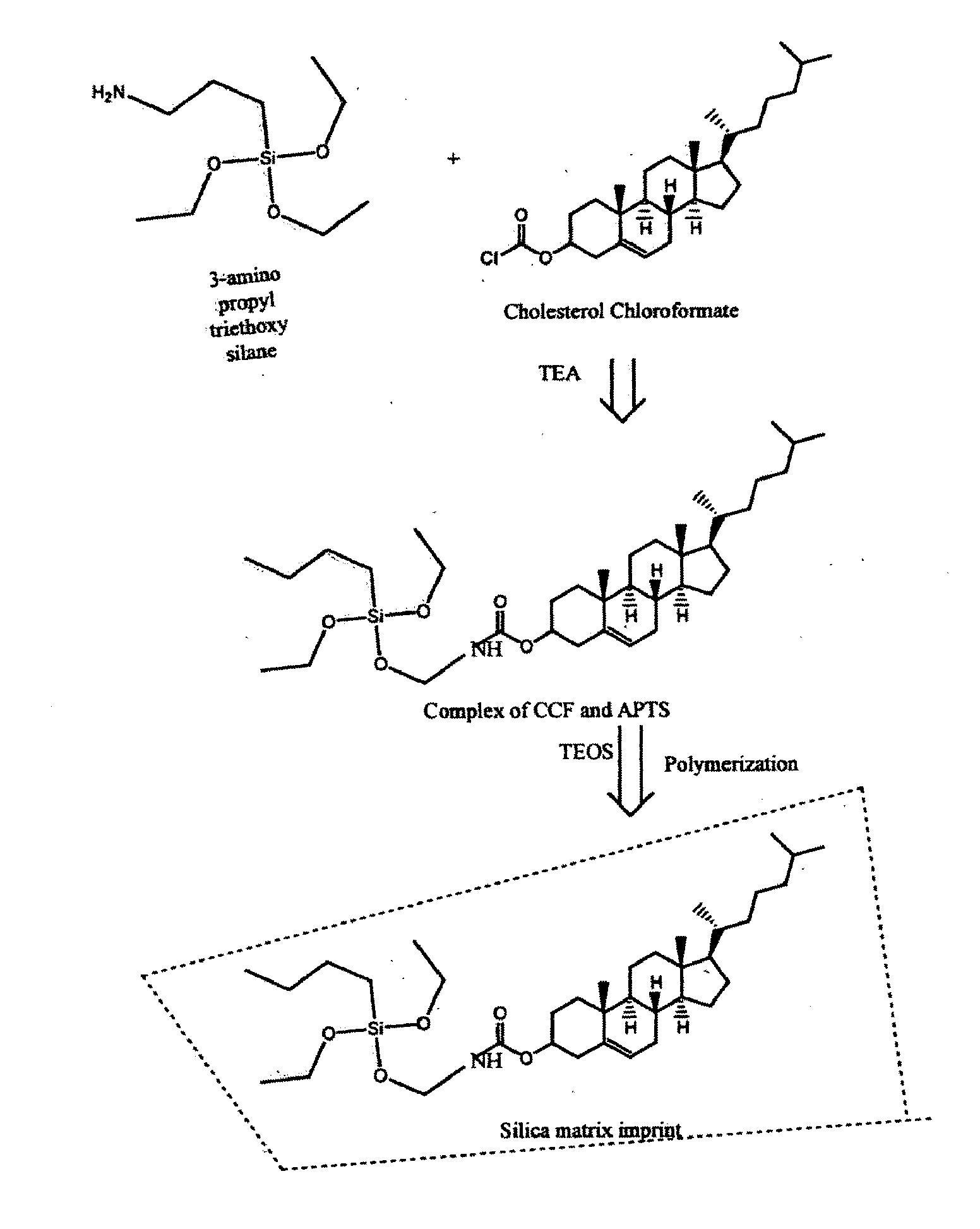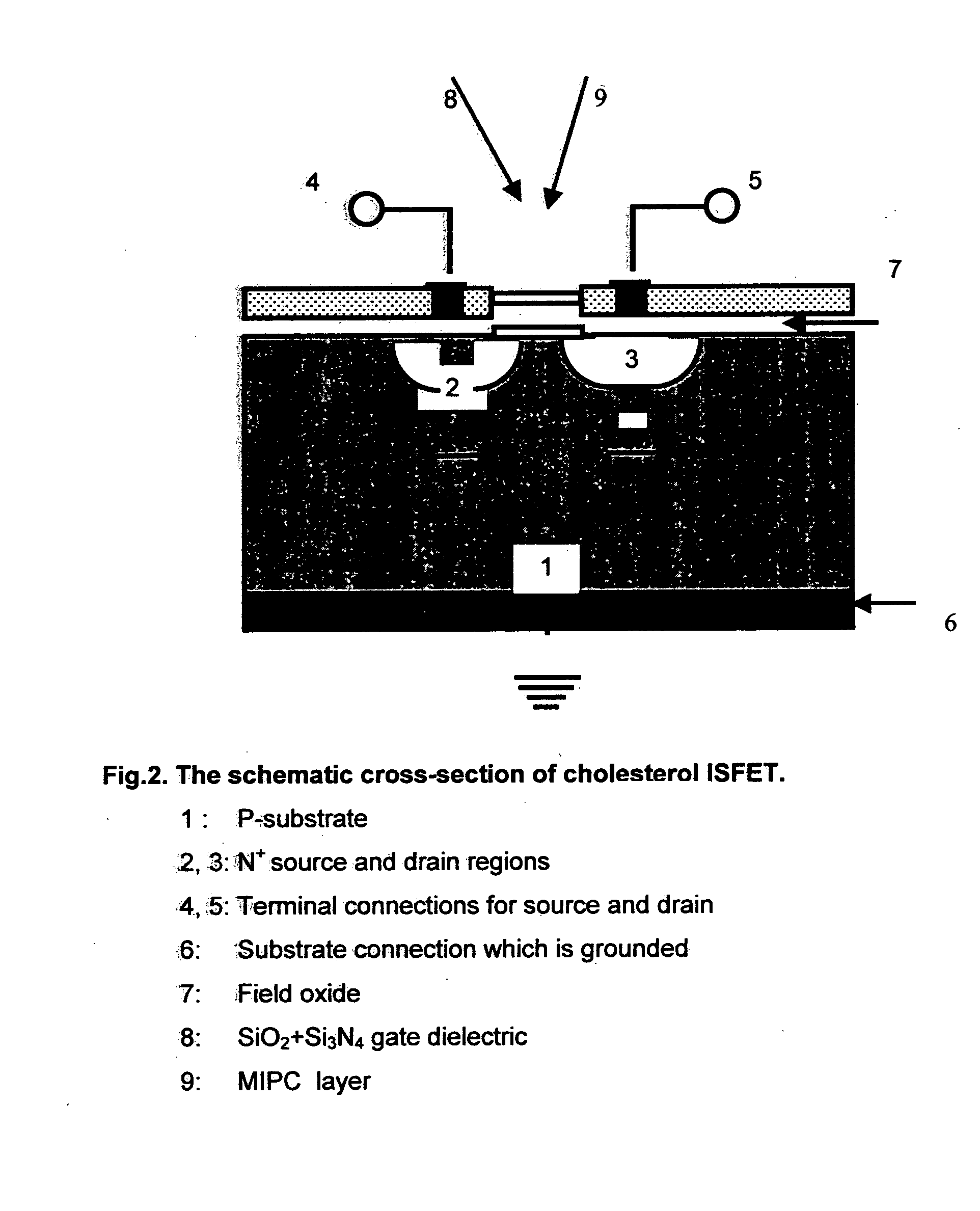Novel potentiometric cholesterol sensor for the quantitative estimation of total cholesterol in human blood serum
a potentiometric and human blood technology, applied in the field of new potentiometric cholesterol sensor for quantitative estimation of total cholesterol in human blood serum, can solve the problems of increased ldl-cholesterol harmful to the body, failure of blood supply, and failure of normal contractile activity in the part of the myocardium
- Summary
- Abstract
- Description
- Claims
- Application Information
AI Technical Summary
Benefits of technology
Problems solved by technology
Method used
Image
Examples
example 1
[0060]Fabrication and Package of ISFET Device:
[0061]ISFET is fabricated of dual dielectric SiO2—Si3N4 gate. The device has been fabricated on P-type Czochralski silicon wafers of resistivity 15-20 ohm-cm (7.4×1014 cm−3) and orientation . Fabrication technology of the ISFET, based on the NMOSFET technology comprised the following processing steps: (i) Field oxidation (1100° C., 30 min. dry O2+120 min. wet O2+30 min. dry O2) giving oxide thickness=0.9 μm, (ii) First photolithography for source / drain N+ diffusion and oxide etching, (iii) Phosphorous diffusion (1050° C., 30 min): Sheet resistance 2, oxygen flow rate 2 litre / min, a little TCE vapour was carried down the tube by a slow bleed of N2 through TCE bubbler at 25° C., tox=140 nm, (vi) Nitridation (LPCVD), 780° C., 25 min, initial pressure=0.02 torr, deposition pressure of dichlorosilane and ammonia gas mixture=0.2 ton, dichlorosilane=20 cc, ammonia 200 cc, gas ratio=1:10, tNitride=100 nm; annealed at 900° C. for 30 min in N2, (v...
example 2
[0062]Preparation of Molecular Imprint of Cholesterol (MIPC):
[0063]The schematic representation of the preparation of molecular imprint of cholesterol is given in FIG. 1. It involves the following 3 steps.
[0064]Step 1: To make Template Molecule
[0065]Cholesteryl Choloroformate (CCF) (0.449 gm) and 3-amino propyl triethoxy silane (APTS) (0.229 gm) were added to 20 ml of Dicholoromethane (DCM) in a 100 ml RB flask. The reaction mixture was kept in an ice bath and stirred for 5-10 minutes; then triethyl amine was added dropwise (1.25 ml) to the reaction mixture and stirring was continued for 12 hours.
[0066]Step 2: Adsorption of CCF on Silica Matrix
[0067]The weight of the resultant product (complex of CCF and APTS) of the first step was of 0.64 g. To this complex, 3% triethoxy silane (TEOS) with respect to the weight of the template weight and 70 ml of dry ethanol were added. Then subsequently, 34 ml of aqueous HCl (pH ˜2.0) were added.
[0068]Step 3: Washing Imprint for the Surface Protec...
example 3
[0070]Deposition of MIPC on the Gate Region of ISFET:
[0071]MIPC was made into a slurry using acetone and applied on the gate region of the ISFET and air dried.
PUM
| Property | Measurement | Unit |
|---|---|---|
| Temperature | aaaaa | aaaaa |
| Temperature | aaaaa | aaaaa |
| Fraction | aaaaa | aaaaa |
Abstract
Description
Claims
Application Information
 Login to View More
Login to View More - R&D
- Intellectual Property
- Life Sciences
- Materials
- Tech Scout
- Unparalleled Data Quality
- Higher Quality Content
- 60% Fewer Hallucinations
Browse by: Latest US Patents, China's latest patents, Technical Efficacy Thesaurus, Application Domain, Technology Topic, Popular Technical Reports.
© 2025 PatSnap. All rights reserved.Legal|Privacy policy|Modern Slavery Act Transparency Statement|Sitemap|About US| Contact US: help@patsnap.com



